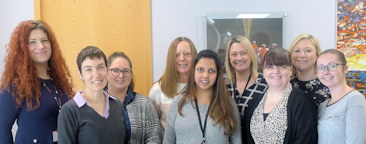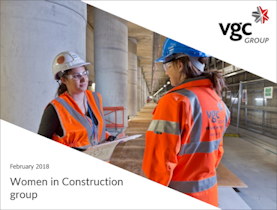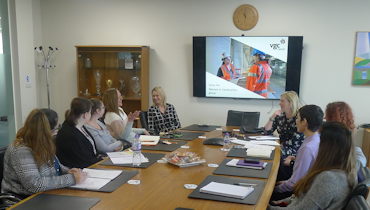Ciara writes:
Our initial Women in Construction group meeting yesterday morning went extremely well.
We were delighted that our chairman, Sean Fitzpatrick, joined us for the start of the meeting. He reaffirmed that we have senior level board support for the group and looks forward to seeing the improvements that we expect as a result of increased diversity.
Why start the group?
- While women make up more than half the UK population, 100 years after (some) women first got the vote, fewer than one third of our members of parliament are women.
- Women make up just 13% of the entire construction industry workforce, and only 16% of senior roles are held by women.
- The construction industry needs a million new entrants by 2020, but there is already a skills shortage. An ageing workforce and a skills exodus because of Brexit are making it worse.
- Diverse teams deliver better results.
What might be behind the problem?
- Girls are given limited information about careers in construction and engineering, and have a poor perception of the options.
- Fewer girls than boys take STEM (science, technology, engineering and maths) subjects.
- Stereotyped attitudes to women abound – the #LikeAGirl campaign (see https://www.youtube.com/watch?v=XjJQBjWYDTs) while dating from 2014, is still relevant, and shows the issue very clearly.
- There aren’t enough influential female role models.
What is VGC doing?
At VGC we have always prided ourselves on our ethical approach to delivering our services. Crossrail gave us an award for maximising employment opportunities, and we are the first labour company in the UK to achieve the Ethical Labour Sourcing Standard.
 We are working to encourage women into construction. Kimberley McGinty, skills and employment adviser, has been running a series of workshops at local schools, and has built partnerships with a number of women and LGBT+ groups. VGC is a member of NAWIC and Women into Construction, and we plan to get involved in the Construction News Inspire Me campaign.
We are working to encourage women into construction. Kimberley McGinty, skills and employment adviser, has been running a series of workshops at local schools, and has built partnerships with a number of women and LGBT+ groups. VGC is a member of NAWIC and Women into Construction, and we plan to get involved in the Construction News Inspire Me campaign.
 However, we need to do more to attract, recruit and retain talented women at all levels. We need momentum, passion, ideas and a change to business-as-usual. We need competent and skilled women to step forward and help us deliver exciting infrastructure projects such as Hinkley Point and HS2.
However, we need to do more to attract, recruit and retain talented women at all levels. We need momentum, passion, ideas and a change to business-as-usual. We need competent and skilled women to step forward and help us deliver exciting infrastructure projects such as Hinkley Point and HS2.
I am optimistic that we can make a change – not only because it is the right thing to do, but because it makes good business sense.
VGC men and women at all levels will work together, with industry and with each other, to make it happen. This group is part of our journey towards increasing women’s participation in our workforce.
Group discussions
We aim to understand the challenges that women of all ages and backgrounds face working in the industry, and to find realistic solutions to reduce the impact of these challenges.
We want to set out a strategy for attracting and retaining women, and to increase female participation in VGC at all levels.
Our group discussion of the challenges faced by women in construction revealed several interesting points. These included:
- Several people mentioned men’s attitudes and language, especially on site, where aggressive and sexist ‘banter’ is frequent.
- It was felt that some men may have a problem reporting to a senior woman.
- It is assumed that a woman working in construction will be junior.
- There are very few senior female role models in construction.
- Responsibilities for caring are not always conducive to site hours.
- Toilets and sanitary facilities on site are a major issue.
If the solution were simple, it would already have been implemented.
However, we also discussed examples of good practice which could be replicated.
- Bechtel was quoted as an example of a flexible employer: they encourage staff to work 80 hours per fortnight, at times that suit them. The best candidates are attracted to companies that show this kind of flexibility.
- Some sites have separate women’s toilets, locked so that they are reserved only for women.
- HS2 uses software to check the language and tone of recruitment advertisements, to ensure they do not imply a gender bias.
- Offering training in subjects such as FIR and unconscious bias
- More commuication to understand better the roles of colleagues, career pathways and opportunities across VGC
- Having a mentor gives someone other than a line manager who can offer advice and support, and raise issues which might be difficult for the woman herself to raise.
What next?

We have ambitious plans!
We will:
- produce a white paper setting out what we will do to increase female participation in construction.
- implement unconscious bias training for our staff, starting with the VGC board of directors.
- implement FIR (fairness, inclusion and respect) training for all VGC staff.
- set up a mentoring system, starting with inviting volunteers.
- continue and build on our schools outreach programme
- review how we advertise vacancies and target recruitment to encourage more women applicants
- build on our external networking with groups such as Women into Construction and NAWIC
- report on gender pay.
We also want to look at how we can build networks for the women in VGC – we will set up a private Facebook group which we can use to support one another.
Monitoring and celebrating success
- We will measure and report on the number of women in our workforce, and the number of female job applicants.
- We will use case studies to celebrate our success.
The group members agreed to meet every two months.
Our next events are to take part in the Big Rail Diversity challenge on 7 June 2018, and we will hold a celebration event on International Women’s Day (8 March).
The numbers
- 1918 – women over 30, who owned property or were married to property-owners, were allowed to vote.
- 1929 – women and men get voting parity
- 1919 – first female MP
- 1979 – first female prime minister
- 2018 – fewer than 1/3 of MPs are women
- Women make up more than half the UK population.
- However, 100 years after 40% of women were allowed to vote for the first time, fewer than one third of members of parliament are women
- Infrastructure and construction affects everyone. But women make up just 13% of the total 3 million construction industry workforce, and only 1% of those work on construction sites.
- For every female apprentice in construction there are 56 males
- Arcadis research published in Feb 2017 suggests that British construction must recruit over 400,000 people each and every year between now and 2021 to meet its construction needs
Here at VGC

- In our office roles, 31.8% are women
- 25% of technical and professional roles are filled by women in Personnel.
Download the meeting’s presentation (1.4MB pdf).
See our sustainability web page for more information about VGC’s work on corporate social responsibility
